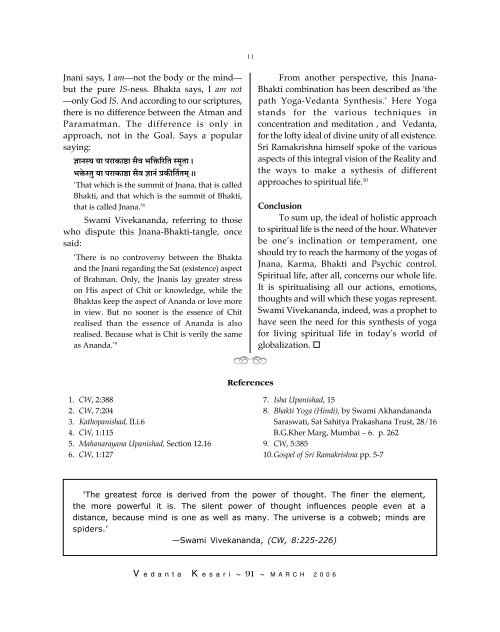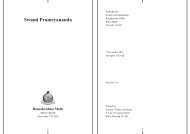Emblem of Holistic Spirituality - Belur Math
Emblem of Holistic Spirituality - Belur Math
Emblem of Holistic Spirituality - Belur Math
Create successful ePaper yourself
Turn your PDF publications into a flip-book with our unique Google optimized e-Paper software.
Jnani says, I am—not the body or the mind—<br />
but the pure IS-ness. Bhakta says, I am not<br />
—only God IS. And according to our scriptures,<br />
there is no difference between the Atman and<br />
Paramatman. The difference is only in<br />
approach, not in the Goal. Says a popular<br />
saying:<br />
kmZÒ` `m namH$mapple>m g°d ^{∫$[a{V Ò_•Vm &<br />
^∫o$ÒVw `m namH$mapple>m g°d kmZß ‡H$s{V©V_≤ &&<br />
‘That which is the summit <strong>of</strong> Jnana, that is called<br />
Bhakti, and that which is the summit <strong>of</strong> Bhakti,<br />
that is called Jnana.’ 8<br />
Swami Vivekananda, referring to those<br />
who dispute this Jnana-Bhakti-tangle, once<br />
said:<br />
‘There is no controversy between the Bhakta<br />
and the Jnani regarding the Sat (existence) aspect<br />
<strong>of</strong> Brahman. Only, the Jnanis lay greater stress<br />
on His aspect <strong>of</strong> Chit or knowledge, while the<br />
Bhaktas keep the aspect <strong>of</strong> Ananda or love more<br />
in view. But no sooner is the essence <strong>of</strong> Chit<br />
realised than the essence <strong>of</strong> Ananda is also<br />
realised. Because what is Chit is verily the same<br />
as Ananda.’ 9<br />
1. CW, 2:388<br />
2. CW, 7:204<br />
3. Kathopanishad, II.i.6<br />
4. CW, 1:115<br />
5. Mahanarayana Upanishad, Section 12.16<br />
6. CW, 1:127<br />
V edanta K esari ~ 91 ~ MARCH 2006<br />
11<br />
<br />
References<br />
From another perspective, this Jnana-<br />
Bhakti combination has been described as 'the<br />
path Yoga-Vedanta Synthesis.' Here Yoga<br />
stands for the various techniques in<br />
concentration and meditation , and Vedanta,<br />
for the l<strong>of</strong>ty ideal <strong>of</strong> divine unity <strong>of</strong> all existence.<br />
Sri Ramakrishna himself spoke <strong>of</strong> the various<br />
aspects <strong>of</strong> this integral vision <strong>of</strong> the Reality and<br />
the ways to make a sythesis <strong>of</strong> different<br />
approaches to spiritual life. 10<br />
Conclusion<br />
To sum up, the ideal <strong>of</strong> holistic approach<br />
to spiritual life is the need <strong>of</strong> the hour. Whatever<br />
be one’s inclination or temperament, one<br />
should try to reach the harmony <strong>of</strong> the yogas <strong>of</strong><br />
Jnana, Karma, Bhakti and Psychic control.<br />
Spiritual life, after all, concerns our whole life.<br />
It is spiritualising all our actions, emotions,<br />
thoughts and will which these yogas represent.<br />
Swami Vivekananda, indeed, was a prophet to<br />
have seen the need for this synthesis <strong>of</strong> yoga<br />
for living spiritual life in today’s world <strong>of</strong><br />
globalization. o<br />
7. Isha Upanishad, 15<br />
8. Bhakti Yoga (Hindi), by Swami Akhandananda<br />
Saraswati, Sat Sahitya Prakashana Trust, 28/16<br />
B.G.Kher Marg, Mumbai – 6. p. 262<br />
9. CW, 5:385<br />
10.Gospel <strong>of</strong> Sri Ramakrishna pp. 5-7<br />
‘The greatest force is derived from the power <strong>of</strong> thought. The finer the element,<br />
the more powerful it is. The silent power <strong>of</strong> thought influences people even at a<br />
distance, because mind is one as well as many. The universe is a cobweb; minds are<br />
spiders.’<br />
—Swami Vivekananda, (CW, 8:225-226)



